MedievalReporter.com
Covering history's most marvelous millennium
Join our newsletter!

Covering history's most marvelous millennium
Covering history's most marvelous millennium
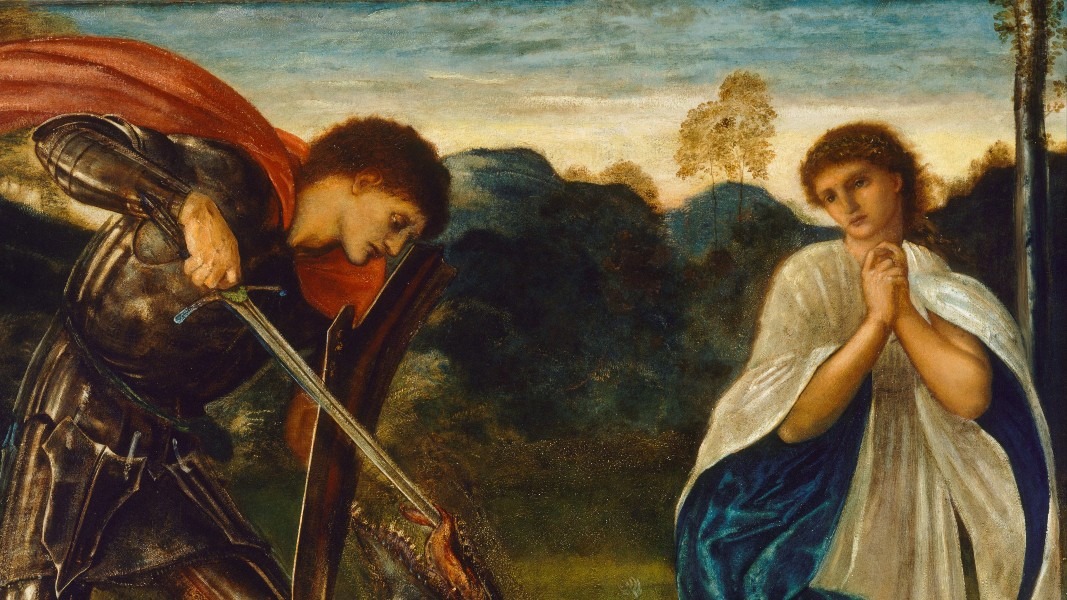
What did people wear in the Early Middle Ages? What clothing options did one have to distinguish oneself from the common peasant? Simply put: if you’re not a princess, how do you dress like one?
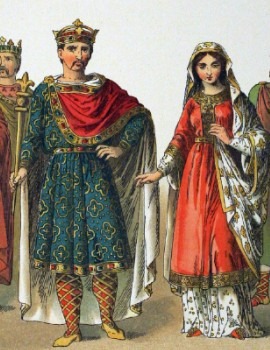
Short version. Question: did medieval fashion even exist? Answer: sort of.
Longer version. Over the course of the Middle Ages, habits in dress and costume did indeed develop and evolve. The changes had one specific goal in mind: to start, play and win status games.
Any modern observer with an Instagram account can tell you that not much has changed since then. Nowadays, we try to highlight our differences with material capital (yachts, private jets, etc). Or with sexual capital – what else are fitgirls and fitboys trying to market?
In medieval times, one conveyed status not just through impressive castles or by having a larger army. Dresses, doublets and other draperies were just as important to delineate princess from peasant. Medieval society was, very much so, a status society.

– advertisement –
– article continues below –
The most visual way of expressing status through clothing in the Middle Ages is by using more expensive materials. At the start of the Medieval Era, there’s a quite simple distinction to make between wool, linen and silk.
Wool was the most basic material. Sheep are relatively cheap to keep, so most poor people wore wool. Because of its warmth, it was also used for capes, cloaks and mantles in northern climates – or during the winter season elsewhere.
Since wool is quite hard on the skin, everybody except the poorest used linen for at least undergarments. And those that could afford it, would use linen for outerwear as well. If there was a medieval middle class, linen would be their material of choice.
For the truly affluent (think high nobility and the royal families), there was something even better. When financially possible, they tried to wear silk from the Far East or cotton from Egypt and the Arab world. These materials were something only the most opulent could afford.
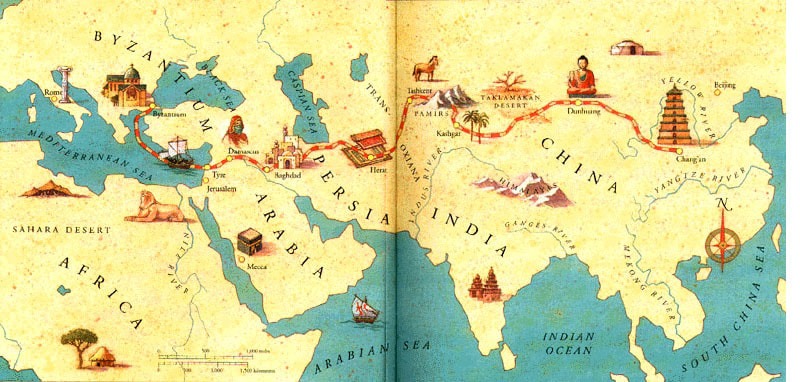
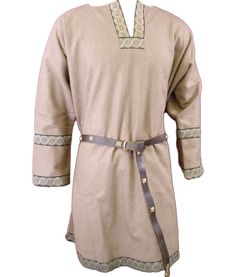
The “barbarian invaders” of the Roman world, regardless of status, wore a lot of wool. The warm material suited the cooler climates of Northern Europe.
As they crossed the Roman Empire’s borders in Late Antiquity, they also crossed climate zones. Stimulated by the hot summers of the Meditteranean, they replaced their sweaty woolen clothing with garments of another fabric, mostly linen, as soon as they could afford to do so.
The garment of choice for outerwear was usually the tunic. In ancient times, Greeks, Romans, Celts, and Germanic peoples already wore this clothing item. It would then go on to become a trademark item during most of the Medieval Era.
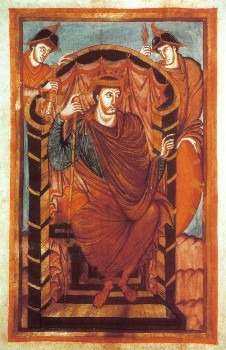
In that age, as much as in ours, people loved to show their influence. An important way to distinguish for status when wearing a tunic was its length. The lower it fell, the higher your rank.
Shorter tunics were associated with manual labor and thus more common – both in the ‘popular’ and the class sense. A longer tunic was more cumbersome to wear. Hence the nobility wore them with pride.
The longest pieces of clothing were reserved for the ones truly set apart: the holier-than-thou types in the clergy. The length of their vestments signified that they took care of spiritual matters. To work the land or fight a war was not their task, so they did not need to dress for such occasions.

‘Rules’ concerning tunic length did present their fair share of problems. What if you were a commoner in a cold climate, probably wearing wool but necessitated by your profession to wear a short tunic? Or, what if you were a nobleman in the south, wearing a quite cool linen tunic but forced by your rank to wear a long one?
The first problem was solved by (woolen) hose, leggings or the continuation of one of the lowest and most barbaric traditions in Roman eyes: wearing braccae (trousers). The second issue could be fixed by wearing a dalmatica (somewhat shorter than a regular tunic) or a scaramangion (a riding coat of Persian origin).
The last two examples are mostly from the Byzantine world, however. Overall, it was expected for a man of rank to simply wear long clothing – just like the Roman senators had worn their togas for centuries.
– advertisement –
– article continues below –
Of course, there were other ways to have oneself noticed and respected. Besides the obvious possibilities with patterns, dyes and embroidery, the Early Medieval Era saw a plethora of adornments. Examples ranged from belts and buckles, as well as brooches, clasps and fibulae.
Anglo-Saxon, 7th century
[by Wikimedia user Robroyaus]
Germanic, 5th century CE
[by Wikimedia user Jdsteakley]
6th century CE or earlier
[by Wikimedia user Rama]
Upper-class women naturally received (or took to) a different treatment. While they may have worn a tunic as an undergarment, they would, for example, resort to wearing coat dresses. The modern presidential or royal allure of this garb apparently goes way, way back.
Probably for the same reasons of attractiveness heard today, slit bodices were introduced for noble ladies in the Early Middle Ages. In early medieval England, the keyhole neckline became quite popular. Whether this innovation was meant to claim back a little modesty or to make breastfeeding a little easier is unknown.
Once a region was christianized, headdresses became mandatory for practically all married women. With this as well, the nobility tried to distance themselves with unwieldy headgear and expensive materials like fur. Common women resorted to simple caps and kerchiefs.
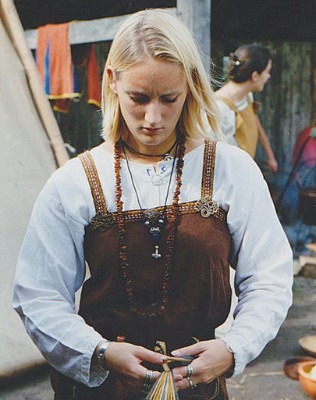
Cultural differences remained in place across medieval Europe. We haven’t even touched upon regional examples yet, such as the Scandinavian apron dress (trägerrock, hängerrock or smokkr). In the more Mediterranean regions, the Ancient Greek peplos remained popular well into the Medieval Era.
Alas, a lot of information about this subject has been lost to us forever for a quite simple reason. As early medieval Europe became more christianized, being buried with your clothes on was increasingly viewed as a pagan ritual. A proper christian need not worry about such earthly matters as clothing – only the soul needs to transfer to the afterlife, after all.
As a result, the archeological track record has been stretched very thin where clothing from the Early Middle Ages is concerned. This report, therefore, simply summarizes the most common Early Medieval styles and dress codes we know of. In a later report, we will take a look at clothing worn during the fantastical and better-known High Middle Ages.
Disclosure: we work hard to provide you with exclusive medieval reports and guides. To make the Middle Ages accessible to everybody, we’d like this information to remain FREE. Therefore, some of the links below are affiliate links, meaning – at no additional cost to you – we will earn a small compensation if you click through.